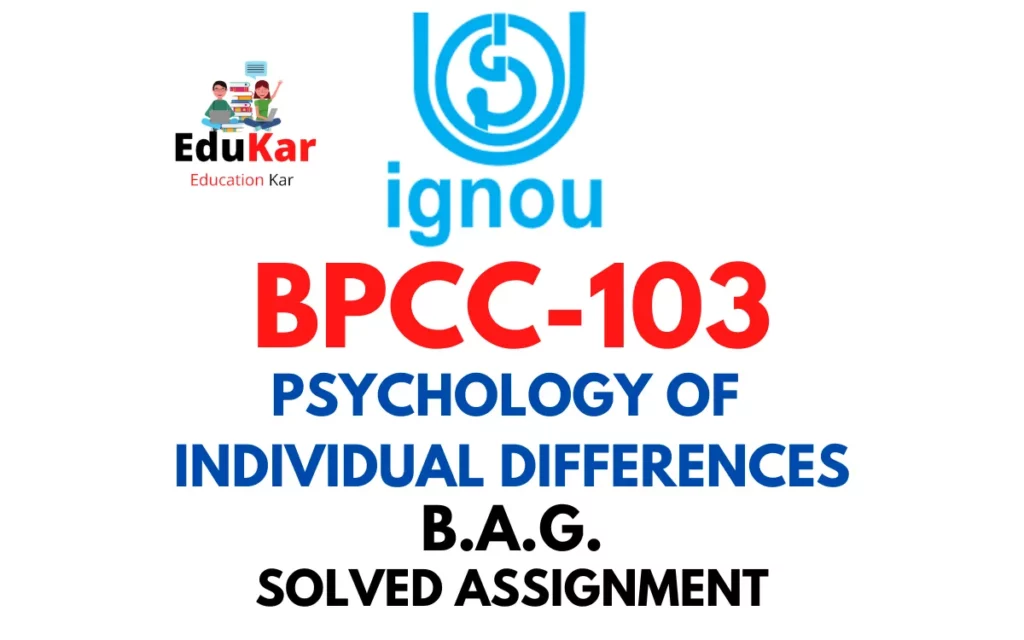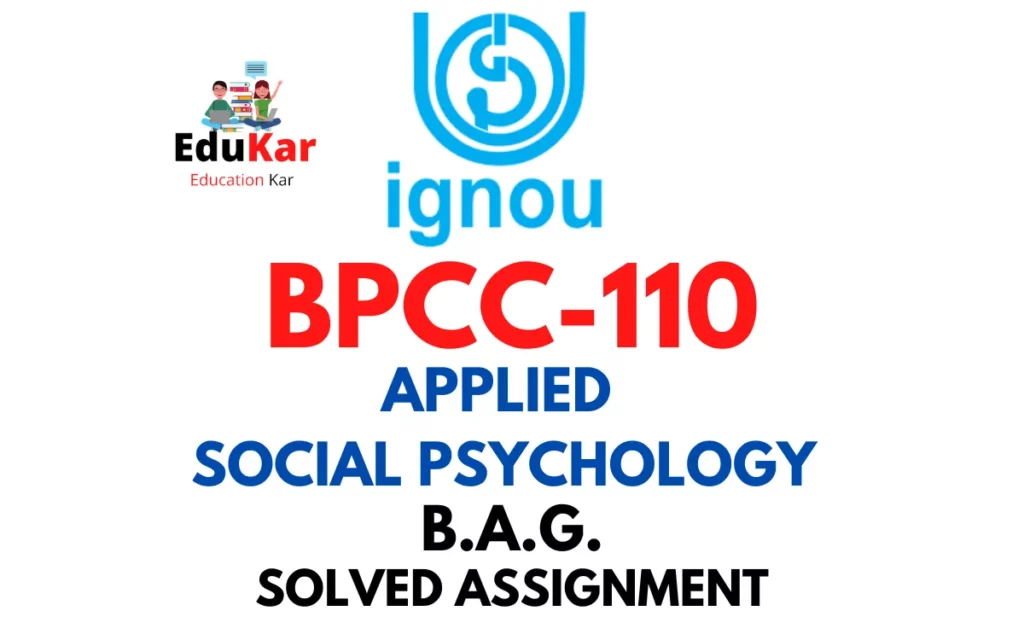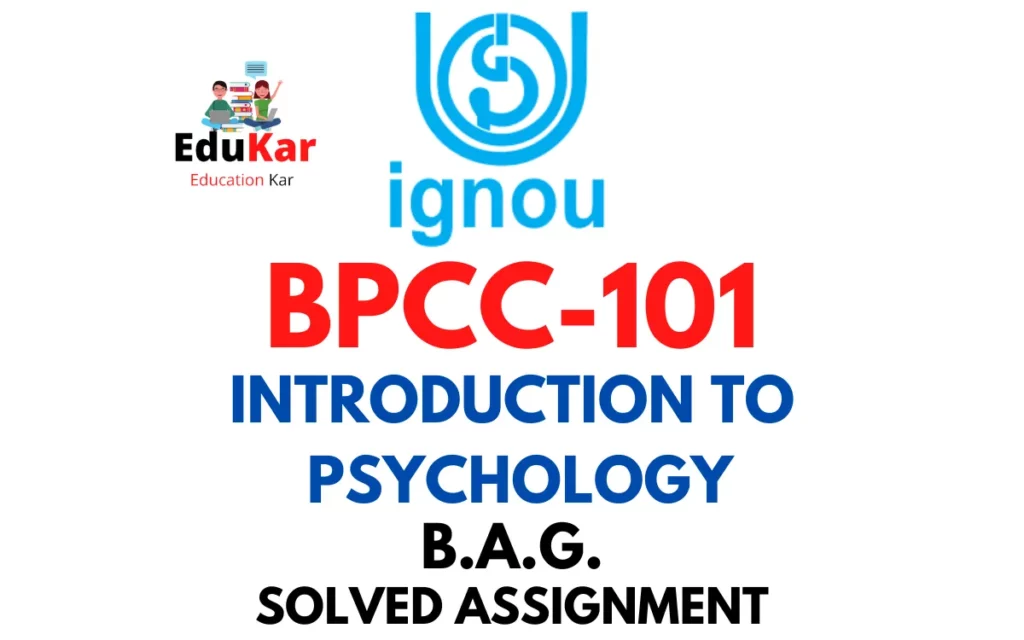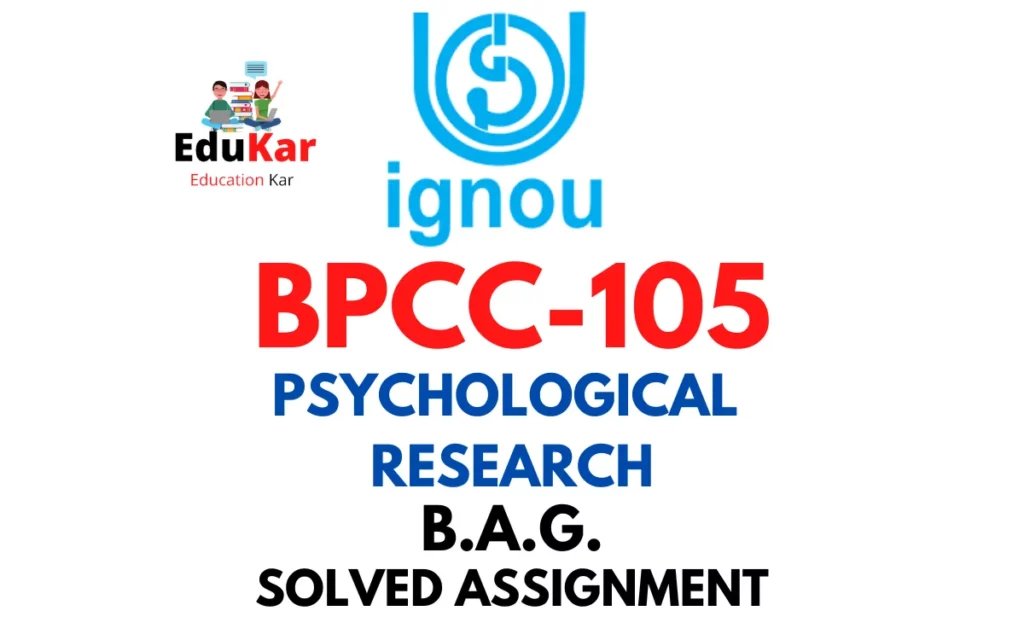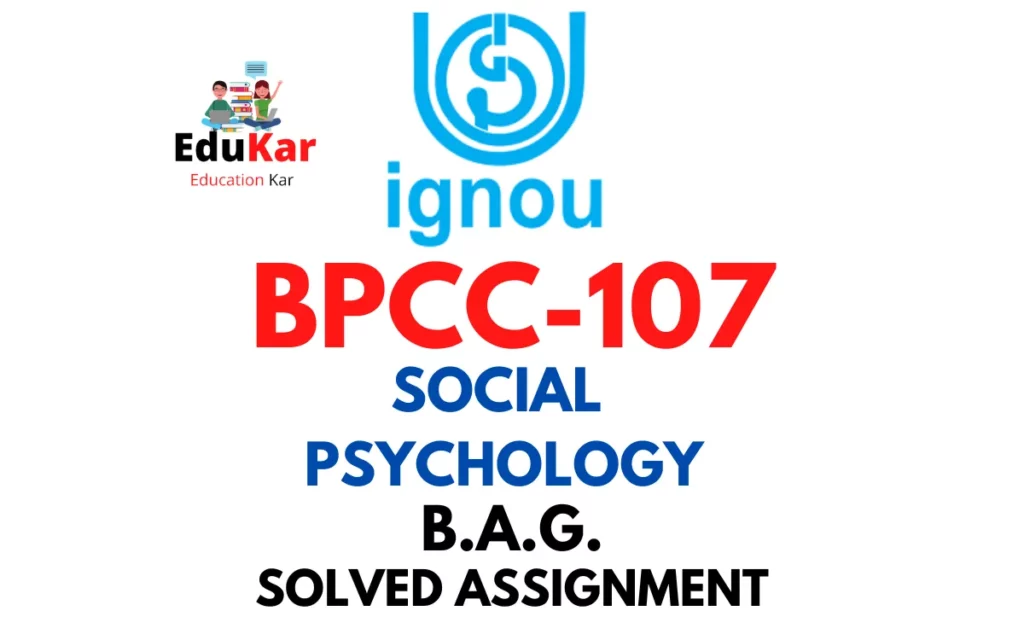Contents
- 1 Assignment One
- 2 Answer the following descriptive category questions in about 500 words each. Eachquestion carries 20 marks.
- 3 1. Discuss the behavioural approaches to psychopathology.
- 4 2. Explain the concept of normality and abnormality.
- 5 Assignment Two
- 6 Answer the following short category questions in about 100 words each. Each question carries 5 marks.
- 7 3. Differentiate between predisposing, precipitating and perpetuating factors in the causation of psychopathology.
- 8 4. Explain different types of attachment styles.
- 9 5. What is clinical interview?
- 10 6. Describe the three phases in cognitive behavior therapy.
- 11 7. Define intellectual disability.
- 12 8. What are the causes of generalized anxiety disorder?
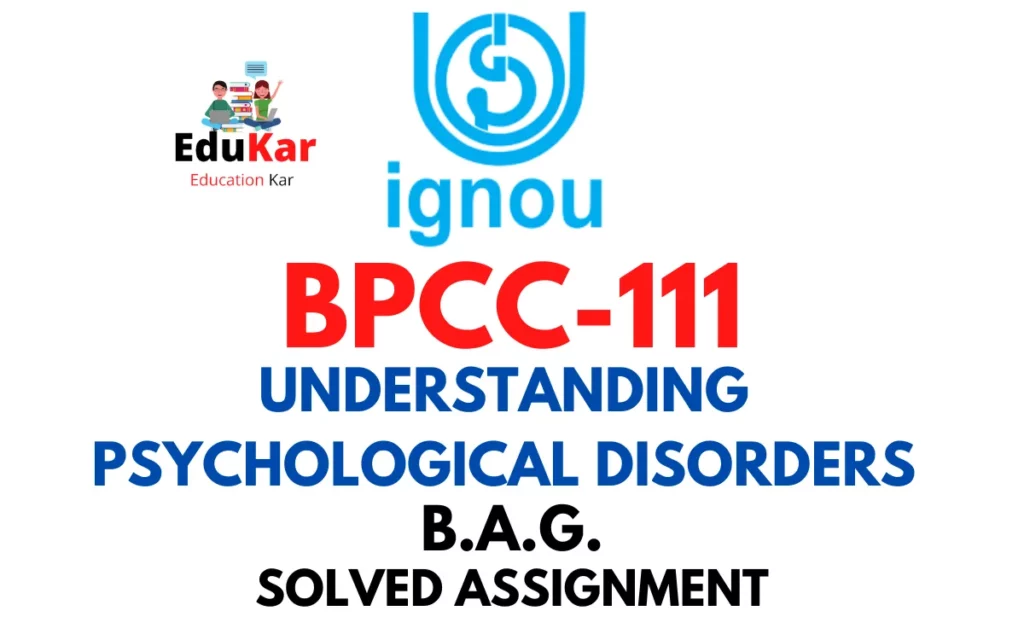
| Title | BPCC-111: IGNOU BAG Solved Assignment 2022-2023 |
| University | IGNOU |
| Degree | Bachelor Degree Programme |
| Course Code | BPCC-111 |
| Course Name | UNDERSTANDING PSYCHOLOGICAL DISORDERS |
| Programme Name | Bachelor of Arts (General) |
| Programme Code | BAG |
| Total Marks | 100 |
| Year | 2022-2023 |
| Language | English |
| Assignment Code | Asst /TMA /2022-23 |
| Assignment PDF | Click Here |
| Last Date for Submission of Assignment: | For June Examination: 31st April For December Examination: 30th September |
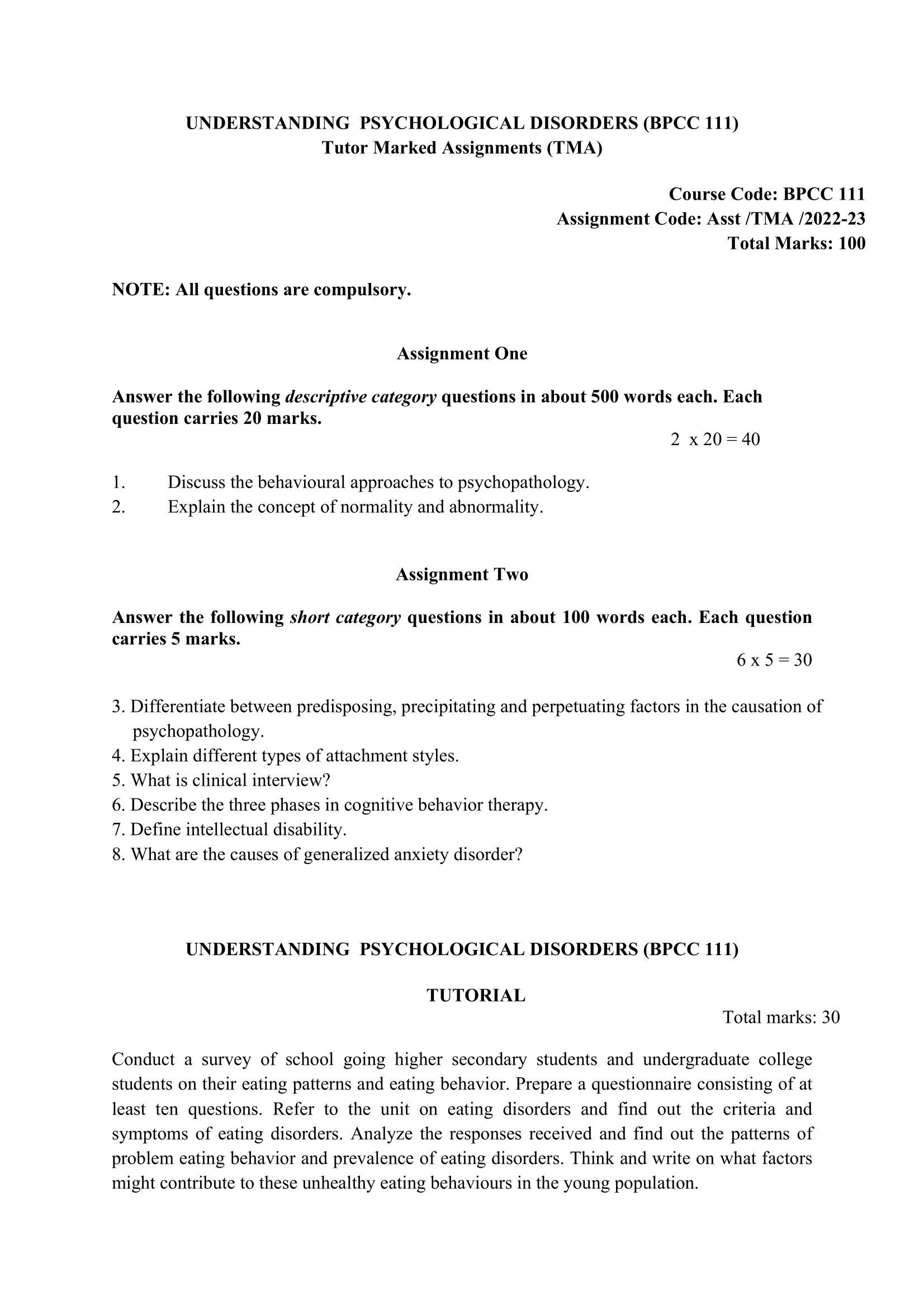
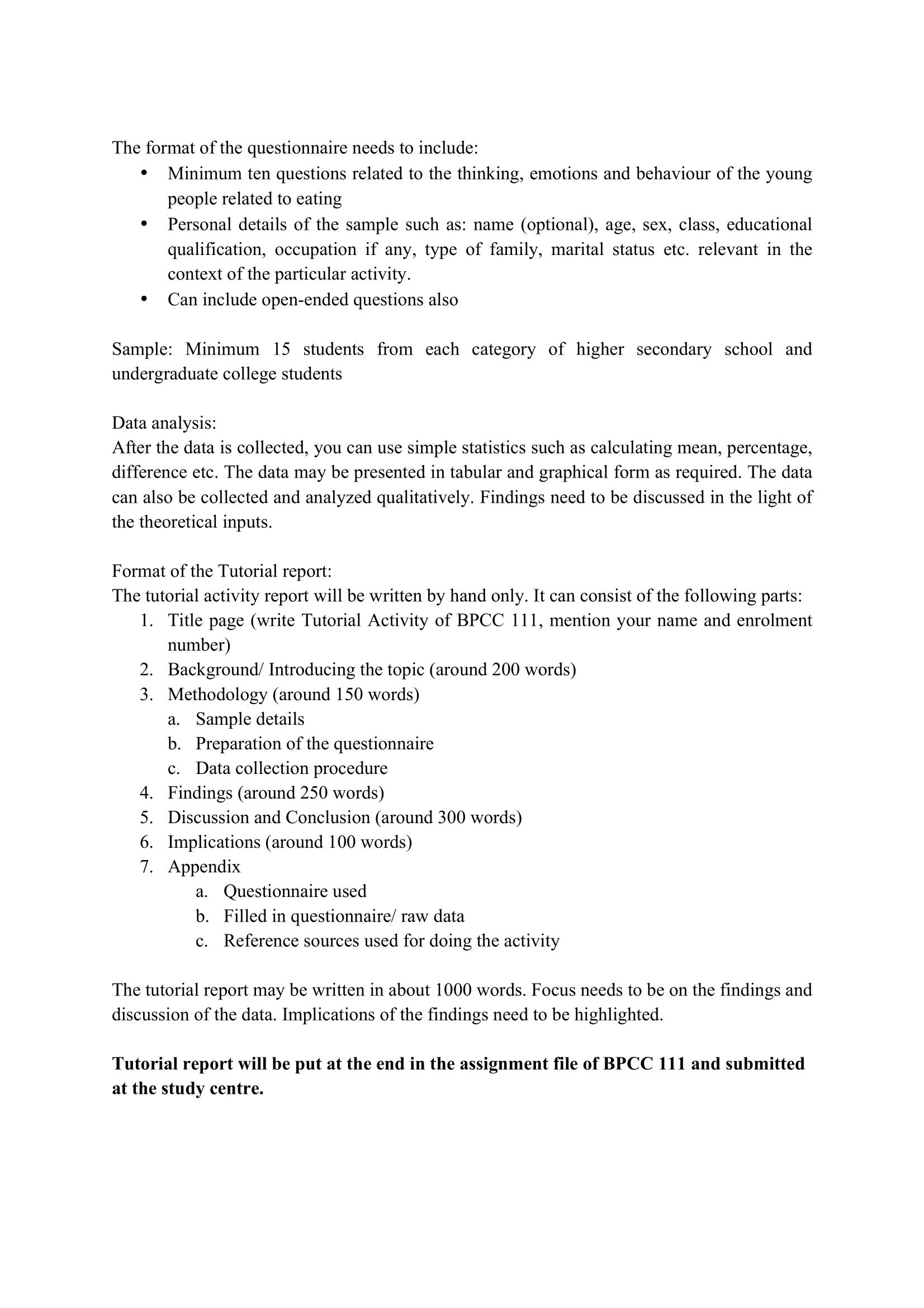
Assignment One
Answer the following descriptive category questions in about 500 words each. Each
question carries 20 marks.
1. Discuss the behavioural approaches to psychopathology.
Ans: The behavioural approach to psychopathology is an approach that focuses on the observable behaviours and environmental factors that contribute to the development of mental disorders. This approach is based on the principles of operant conditioning, classical conditioning, and social learning theory. Behavioural theorists believe that mental disorders are learned behaviours that are the result of the individual’s interaction with their environment. In this essay, I will discuss the behavioural approaches to psychopathology, including the principles of classical conditioning, operant conditioning, and social learning theory.
Classical conditioning is the process by which an individual learns to associate a neutral stimulus with a previously meaningful stimulus. In the context of mental disorders, this may occur when an individual associates an event or stimulus with a negative experience or emotion. For example, an individual who has experienced a traumatic event may develop a phobia of the stimulus associated with the event. Classical conditioning can also be used to treat mental disorders through exposure therapy, in which an individual is gradually exposed to the feared stimulus until they no longer experience fear.
Operant conditioning is the process by which an individual’s behaviour is shaped through consequences. Positive reinforcement occurs when a behaviour is followed by a positive consequence, increasing the likelihood that the behaviour will occur again. Negative reinforcement occurs when a behaviour is followed by the removal of an aversive stimulus, also increasing the likelihood that the behaviour will occur again. Punishment occurs when a behaviour is followed by an aversive consequence, decreasing the likelihood that the behaviour will occur again. Behavioural therapies, such as token economies and contingency management, are based on the principles of operant conditioning.
Social learning theory is the process by which an individual learns by observing the behaviour of others. This can occur through modelling, in which an individual learns by observing the behaviour of a model and the consequences of their behaviour. In the context of mental disorders, this may occur when an individual observes maladaptive behaviours in others and learns to imitate those behaviours. Behavioural therapies based on social learning theory, such as social skills training and role-playing, aim to teach individuals adaptive behaviours through modelling and practice.
Behavioural approaches to psychopathology have been applied to a variety of mental disorders. For example, behavioural therapies, such as exposure therapy and systematic desensitization, have been used to treat anxiety disorders. Token economies and contingency management have been used to treat substance use disorders. Social skills training and role-playing have been used to treat social anxiety disorder and other disorders characterized by social deficits. Behavioural approaches have also been used to treat autism spectrum disorders, obsessive-compulsive disorder, and eating disorders.
2. Explain the concept of normality and abnormality.
Ans: The concepts of normality and abnormality are fundamental in the field of psychology and mental health. Normality refers to behaviours, thoughts, and emotions that are consistent with the general population’s expectations, whereas abnormality refers to behaviours, thoughts, and emotions that deviate from the norm. The definitions of normality and abnormality are influenced by cultural, social, and historical factors and have evolved over time. In this essay, I will explain the concept of normality and abnormality, including the different approaches to defining and measuring normality.
One approach to defining normality is the statistical approach, which defines normality as the behaviours, thoughts, and emotions that are statistically typical or average for the general population. This approach assumes that normality can be determined by measuring the frequency or distribution of a particular behaviour or trait in the population. For example, the average height, weight, or intelligence quotient (IQ) of a population is considered the norm, and individuals who deviate significantly from the norm are considered abnormal. The statistical approach has the advantage of being objective and data-driven, but it may fail to consider cultural or individual differences.
Another approach to defining normality is the subjective approach, which defines normality based on an individual’s subjective experience of their own behaviour, thoughts, and emotions. This approach recognizes that individuals have different experiences and perspectives and that what may be normal for one individual may not be normal for another. For example, an individual who experiences severe anxiety in social situations may consider their anxiety to be abnormal, even if it is statistically common. The subjective approach has the advantage of considering individual differences, but it may lack consistency and objectivity.
A third approach to defining normality is the functional approach, which defines normality based on an individual’s ability to function effectively in their environment. This approach focuses on whether an individual’s behaviour, thoughts, and emotions are adaptive and contribute to their well-being and functioning. For example, an individual who experiences mild depression but is still able to work, maintain relationships, and engage in activities they enjoy may be considered normal, whereas an individual who experiences severe depression and is unable to function in their daily life may be considered abnormal. The functional approach has the advantage of considering the context and function of behaviour, but it may be subjective and dependent on cultural and societal expectations of functioning.
In addition to the different approaches to defining normality, there are also different ways of measuring abnormality. One way is to use diagnostic criteria, which are standardized sets of symptoms and behaviours that are used to identify mental disorders. Diagnostic criteria are used in the Diagnostic and Statistical Manual of Mental Disorders (DSM), which is widely used by mental health professionals to diagnose and treat mental disorders. Another way of measuring abnormality is to use self-report measures, which are questionnaires or surveys that assess an individual’s symptoms and experiences. Self-report measures are often used in research and clinical practice to assess an individual’s mental health and to track their progress over time.
Assignment Two
Answer the following short category questions in about 100 words each. Each question carries 5 marks.
3. Differentiate between predisposing, precipitating and perpetuating factors in the causation of psychopathology.
Ans: Predisposing factors refer to the pre-existing factors or conditions that make an individual vulnerable to developing a mental disorder. Examples of predisposing factors include genetics, childhood experiences, personality traits, and environmental factors.
Precipitating factors are specific events or experiences that trigger the onset of a mental disorder. These factors can be acute stressors, such as a traumatic event or a significant loss, or chronic stressors, such as ongoing relationship problems or financial difficulties.
Perpetuating factors are the factors that maintain or exacerbate an existing mental disorder. These factors can include ongoing stressors, maladaptive coping mechanisms, and negative patterns of thinking or behavior. Perpetuating factors can make it difficult for an individual to recover from a mental disorder without professional help and support.
4. Explain different types of attachment styles.
Ans: Attachment theory suggests that the quality of the relationship between a child and their caregiver(s) shapes the child’s emotional and social development. Based on this theory, researchers have identified four main types of attachment styles that individuals can develop based on their early experiences with their caregivers. These attachment styles are:
- Secure attachment: Individuals with a secure attachment style feel comfortable with both intimacy and independence in their relationships. They trust their partners and are confident that their needs will be met. They tend to have positive views of themselves and their partners, and they are able to communicate their feelings and needs effectively.
- Avoidant attachment: Individuals with an avoidant attachment style tend to be emotionally distant and self-reliant. They may have learned to suppress their emotions and avoid close relationships as a way of protecting themselves from rejection or abandonment. They may have negative views of themselves and their partners, and they may find it difficult to express their emotions.
- Ambivalent attachment: Individuals with an ambivalent attachment style tend to be preoccupied with their relationships and have a strong desire for intimacy. However, they may also fear abandonment and may feel insecure about their partner’s feelings for them. They may have negative views of themselves but positive views of their partners.
- Disorganized attachment: Individuals with a disorganized attachment style have inconsistent or contradictory patterns of behavior in their relationships. They may have experienced significant trauma or abuse in their early childhood, which can lead to a disorganized or confused approach to relationships as an adult.
5. What is clinical interview?
Ans: A clinical interview is a conversation between a mental health professional and an individual seeking psychological or psychiatric services. The primary goal of a clinical interview is to gather information about the individual’s mental health symptoms, history, and current functioning to help diagnose and develop an appropriate treatment plan.
Clinical interviews can vary in structure and format, but they typically involve a mental health professional asking a series of open-ended questions to gather information about the individual’s:
- Personal background and history (e.g., family history, educational and occupational history)
- Current and past mental health symptoms (e.g., depression, anxiety, hallucinations, delusions)
- Social and interpersonal relationships (e.g., relationships with family, friends, and romantic partners)
- Coping strategies and methods for managing stress or difficult emotions
- Physical health and any relevant medical history
- Substance use or history of addiction
- Trauma or past experiences that may have contributed to the individual’s current symptoms
The mental health professional may also ask questions to assess the individual’s level of risk for self-harm or harm to others and to identify any factors that may interfere with treatment.
Clinical interviews may be conducted in-person or remotely through teletherapy. They are typically the first step in the mental health treatment process, and the information gathered during the interview helps the mental health professional to develop a personalized treatment plan to address the individual’s specific needs.
6. Describe the three phases in cognitive behavior therapy.
Ans: Cognitive-behavioral therapy (CBT) is a form of psychotherapy that is based on the idea that an individual’s thoughts, emotions, and behaviors are interconnected and can influence each other. CBT is typically divided into three phases:
- The first phase involves assessment and conceptualization. During this phase, the therapist and client work together to identify the client’s goals for therapy, assess the client’s current emotional and behavioral patterns, and develop an understanding of the underlying thoughts and beliefs that contribute to the client’s symptoms. The therapist may use various techniques such as standardized assessments, behavioral observation, and self-report measures to gather information and establish a treatment plan.
- The second phase involves active treatment. During this phase, the therapist and client work together to identify and modify the negative thoughts and beliefs that contribute to the client’s symptoms. The therapist may use various cognitive and behavioral techniques such as cognitive restructuring, exposure therapy, and behavioral activation to help the client learn new coping skills and change maladaptive patterns of thinking and behavior. The client may also be encouraged to practice the new skills in their daily life and to monitor their progress toward their goals.
- The third phase involves maintenance and relapse prevention. During this phase, the therapist and client work together to consolidate the gains made during treatment and to develop a plan for maintaining progress and preventing relapse. The client may continue to practice the skills they learned in therapy and to monitor their thoughts and behaviors for signs of relapse. The therapist may also help the client identify potential triggers for relapse and develop strategies for coping with stress and difficult emotions.
7. Define intellectual disability.
Ans: Intellectual disability, also known as intellectual developmental disorder (IDD), is a condition characterized by significant limitations in intellectual functioning and adaptive behavior. Intellectual functioning refers to an individual’s ability to learn, reason, problem-solve, and understand abstract concepts. Adaptive behavior refers to an individual’s ability to meet the demands of daily life, such as self-care, communication, socialization, and independent living skills.
Intellectual disability is diagnosed when an individual has an IQ score of approximately 70 or below and significant limitations in adaptive behavior that impact their daily functioning. The condition typically becomes apparent during childhood or adolescence and can be caused by a variety of factors, including genetic conditions, brain damage or injury, infections, malnutrition, or exposure to toxins.
Intellectual disability is usually diagnosed through a comprehensive evaluation that includes intelligence testing, assessment of adaptive behavior, and a medical and developmental history. The diagnosis is based on the extent of limitations in intellectual functioning and adaptive behavior, as well as the individual’s level of independence and need for support.
Treatment for intellectual disability focuses on helping individuals develop the skills and supports they need to function as independently as possible. This may involve special education programs, speech and language therapy, occupational therapy, behavioral therapy, and other interventions. With appropriate support and intervention, many individuals with intellectual disability can lead fulfilling lives and achieve their full potential.
8. What are the causes of generalized anxiety disorder?
Ans: Generalized Anxiety Disorder (GAD) is a mental health disorder characterized by excessive and persistent worry and anxiety about various aspects of life. The causes of GAD are not entirely clear, but research suggests that a combination of genetic, environmental, and psychological factors may contribute to its development.
Some of the genetic factors that may increase the risk of developing GAD include a family history of anxiety disorders and variations in certain genes associated with stress and anxiety. Environmental factors such as trauma, abuse, and chronic stress may also increase the risk of developing GAD.
Psychological factors such as negative thinking patterns, low self-esteem, and a tendency to catastrophize or overestimate the likelihood of negative outcomes may also contribute to the development of GAD. Additionally, imbalances in brain chemicals such as serotonin, norepinephrine, and gamma-aminobutyric acid (GABA) may play a role in the development of GAD.
Effective treatment for GAD typically involves a combination of medication, therapy, and lifestyle changes. With appropriate treatment and support, individuals with GAD can learn to manage their symptoms and improve their overall quality of life.
How to Download BPCC-111 Solved Assignment?
You can download it from the www.edukar.in, they have a big database for all the IGNOU solved assignments.
Is the BPCC-111 Solved Assignment Free?
Yes this is absolutely free to download the solved assignment from www.edukar.in
What is the last submission date for BPCC-111 Solved Assignment?
For June Examination: 31st April, For December Examination: 30th October

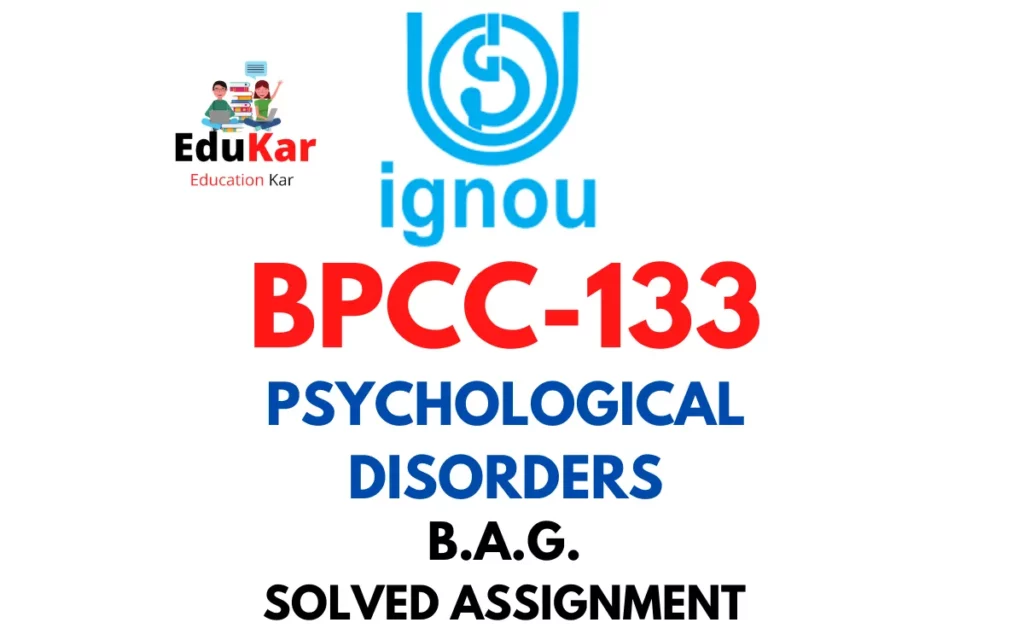
![[Solved Assignment] BPCS 188-APPLICATIONS OF SOCIAL PSYCHOLOGY (IGNOU-BAG) 2022-2023 BPCS 188-APPLICATIONS OF SOCIAL PSYCHOLOGY IGNOU BAG Solved Assignment 2022-2023](https://edukar.in/wp-content/uploads/2023/01/BPCS-188-APPLICATIONS-OF-SOCIAL-PSYCHOLOGY-IGNOU-BAG-Solved-Assignment-2022-2023-1024x640.webp)
